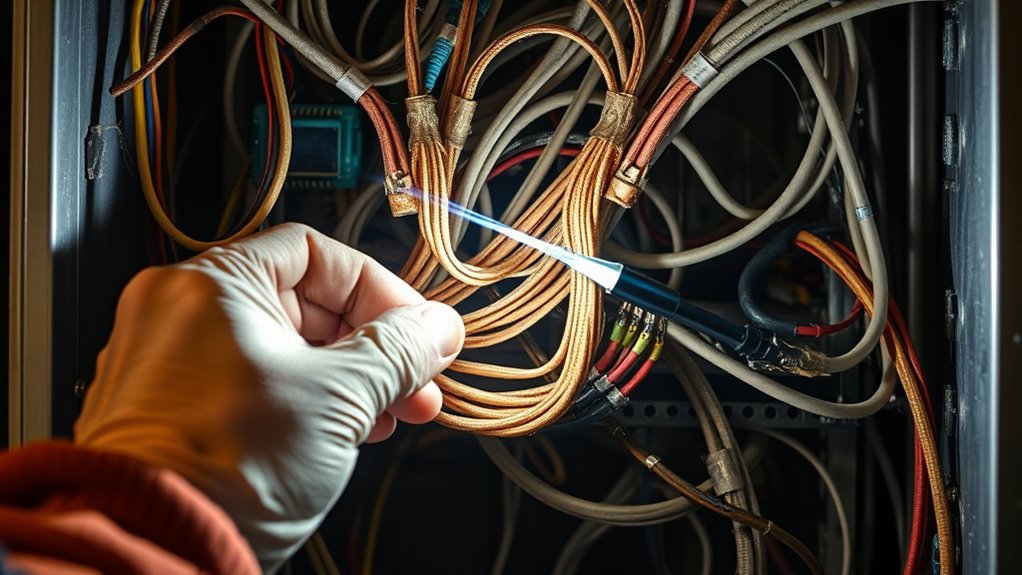To upgrade old cabling to new standards, first assess your existing infrastructure for compatibility, capacity, and condition. Choose appropriate retrofit options like installing modern patch panels, connectors, or switching to wireless solutions if suitable. Organize cables with proper management and labeling for easier maintenance. Test and certify your setup to guarantee reliability. Planning ahead for future needs can save time and costs later. Keep going to discover detailed strategies for a seamless upgrade.
Key Takeaways
- Assess existing cabling for compatibility, capacity, and condition to determine suitable upgrade strategies.
- Consider wireless solutions like Wi-Fi upgrades or mesh networks as alternatives to physical cabling.
- Use Power over Ethernet (PoE) and high-quality connectors to retrofit and enhance existing infrastructure.
- Implement organized cable management, clear labeling, and proper routing for easier maintenance and future expansion.
- Conduct comprehensive testing and certification post-upgrade to ensure reliability, compliance, and system longevity.
Assessing Your Existing Cabling Infrastructure
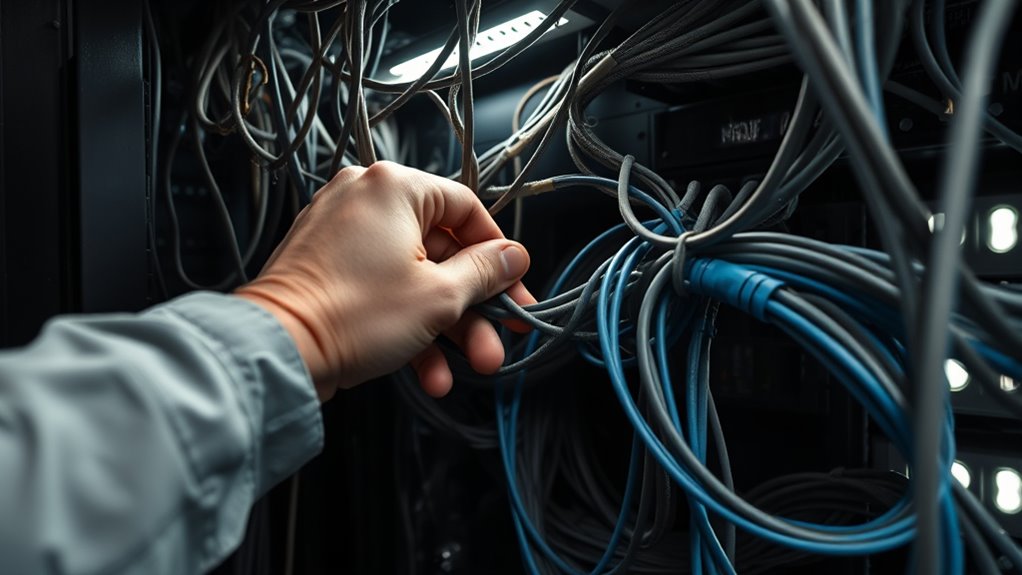
Before considering any retrofit options, you need to evaluate your current cabling infrastructure thoroughly. Check if your existing cables support fiber optic connections, which offer higher bandwidth and better long-term scalability. Determine whether your setup provides adequate power redundancy to prevent outages during failures. Inspect the age and condition of your cables, connectors, and switches; outdated or damaged components may require immediate replacement. Assess your network’s capacity to handle future demands and ensure your cabling layout aligns with best practices for performance and safety. Identifying gaps or weaknesses now helps you plan effectively, avoiding costly mistakes later. Conducting a comprehensive assessment can reveal potential compatibility issues and help you optimize your upgrade strategy. A detailed evaluation ensures your retrofit approach is tailored to your needs, maximizing reliability, speed, and resilience of your upgraded network. Additionally, evaluating your current air quality can help identify environmental factors that may affect equipment longevity and performance. Recognizing energy flow within your system can also aid in understanding how to improve efficiency and reduce potential interference.
Choosing the Right Retrofit Method for Your Needs
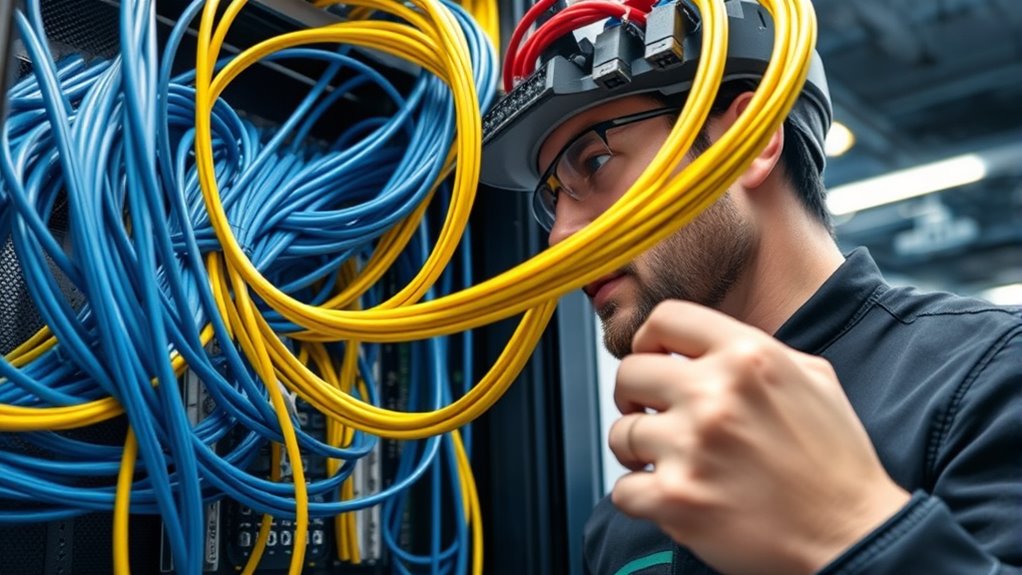
Selecting the appropriate retrofit method depends on your current infrastructure, future needs, and budget constraints. If your building supports older cabling, consider wireless alternatives like Wi-Fi upgrades or mesh networks to improve connectivity without extensive rewiring. For a more reliable, high-speed solution, power over Ethernet (PoE) can retrofit existing cabling, enabling device power and data transfer through a single cable. PoE is ideal if your infrastructure can handle it, providing scalability and reducing clutter. If your needs are minimal and budget tight, wireless options may suffice temporarily. However, for long-term stability and performance, upgrading to structured cabling combined with PoE offers the best results. Carefully evaluate your specific requirements and future growth plans to choose the most effective retrofit method. Maximize Space and Organization Additionally, assessing your current cabling standards can help identify compatibility issues and guide your upgrade plan, especially as newer networking technologies continue to evolve rapidly. Ensuring your cabling meets current industry standards can prevent potential issues and facilitate smoother upgrades in the future.
Installing New Patch Panels and Connectors
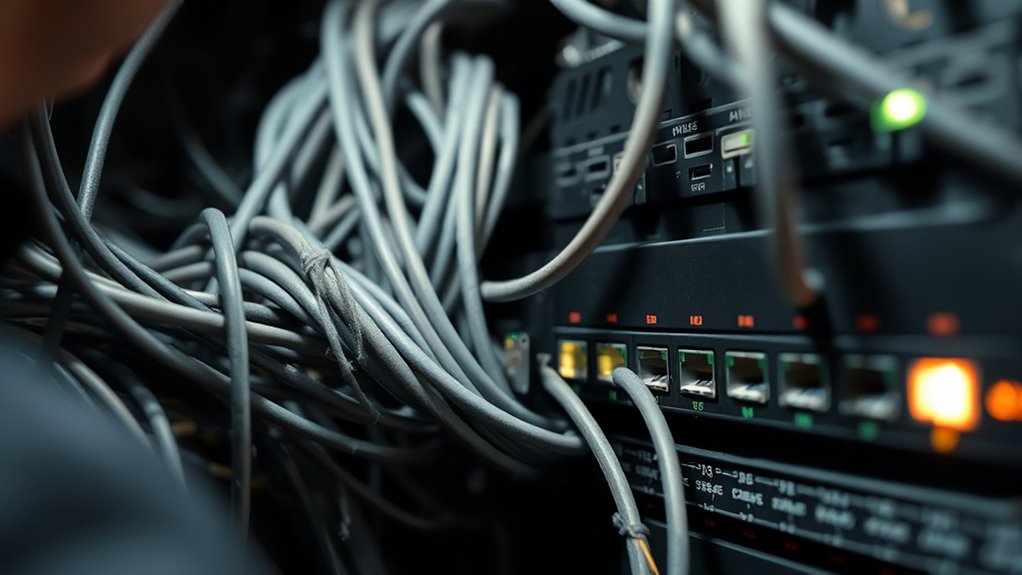
Installing new patch panels and connectors is a critical step in upgrading your network infrastructure to guarantee better performance and easier management. When selecting new components, prioritize fiber security to prevent unauthorized access and ensure data integrity. Using high-quality connectors enhances signal quality and reduces potential issues. Pay attention to cable aesthetics by organizing cables neatly and securing them properly, which not only improves airflow but also makes future troubleshooting simpler. Proper installation helps minimize crosstalk and interference, maintaining network reliability. Upgrading to modern patch panels allows for easier scalability and faster reconfiguration. Additionally, implementing proper cable management practices can significantly improve overall network performance and maintenance efficiency. Ensuring cable organization not only enhances the appearance but also reduces the risk of accidental disconnections or damage. Regularly inspecting and maintaining your cabling system ensures long-term network stability and is a key aspect of cabling best practices. Overall, well-chosen and correctly installed patch panels and connectors notably boost your network’s efficiency, security, and appearance, laying a solid foundation for future upgrades and growth.
Implementing Cable Management and Pathways

You need to plan your cable routes carefully to avoid clutter and make certain of easy access. Using trays helps keep cables organized and prevents tangling. Label everything clearly so you can quickly identify connections during maintenance or troubleshooting. Incorporating privacy policies to inform users about data handling can also enhance transparency in your cable management documentation. Additionally, understanding proper cable management techniques can significantly reduce the risk of damage and improve overall system reliability. Incorporating juice cleanse principles, such as selecting nutrient-rich pathways for cables, can optimize system performance and longevity. Moreover, adopting conflict resolution strategies can help address any issues that arise during installation or maintenance, ensuring smoother operations.
Planning Cable Routes
Effective planning of cable routes is crucial to guarantee a neat, efficient, and accessible network infrastructure. You should map out pathways that accommodate current needs and future growth, minimizing interference and congestion. Consider fiber optic cables for high-speed data transfer, ensuring they run along dedicated, protected routes. Incorporate wireless integration points where possible to reduce cabling and simplify maintenance. Use existing conduits or wall cavities to keep cables hidden and organized. Avoid sharp bends and tight spaces that can damage cables or hinder airflow. Clear labeling along the routes helps with troubleshooting and upgrades later. Proper planning prevents clutter and makes future upgrades easier, ensuring your network remains reliable and scalable over time. Additionally, understanding popular juice brands and their features can help optimize cable pathways for better performance and accessibility. Incorporating mental wellbeing principles into your planning process can foster a more mindful and adaptable approach to infrastructure design, benefiting overall project success.
Being aware of privacy and cookie usage guidelines can also inform how you structure access points and security measures within your network layout.
Organizing With Trays
Organizing cables with trays streamlines your network setup by providing dedicated pathways that keep cables neat and accessible. Using trays helps prevent cable clutter, making maintenance easier and reducing the risk of damage. Proper cable insulation within trays is essential to safeguard against electrical faults and ensure safety. Well-organized trays also enhance fire safety by minimizing the risk of overheating and accidental contact with combustible materials. When installing trays, ensure they support the weight of all cables and allow for airflow to prevent heat buildup. Clear pathways facilitate future upgrades and troubleshooting, saving time and effort. By investing in cable trays, you create a safer, more efficient environment that complies with safety standards and extends the lifespan of your cabling infrastructure.
Labeling for Clarity
Have you ever struggled to trace a specific cable or troubleshoot a connection? Effective labeling can make a huge difference. Use color coding to quickly identify cable types or functions—red for power, blue for data, green for audio, for example. When placing labels, guarantee they’re visible and consistent; label placement should be near connectors or junction points for easy reference. Clear labels prevent confusion during maintenance and reduce troubleshooting time. Keep labels legible with large fonts and durable materials, especially in high-traffic areas. Proper cable management combined with strategic labeling creates a clean, organized setup. This approach minimizes errors, speeds repairs, and ensures your system stays compliant with standards. Additionally, incorporating affiliate marketing principles like clear labeling can enhance your overall system organization and user experience. Clarity in labeling ultimately saves you time and effort in managing your upgraded cabling infrastructure, especially when combined with lifecycle management practices that support ongoing maintenance and upgrades. Utilizing cable organization techniques can further improve your setup by maintaining a tidy environment and simplifying future upgrades. Being aware of filtration technologies allows you to optimize your cable pathways by preventing dust and debris buildup that could affect performance.
Testing and Certification of the Upgraded System
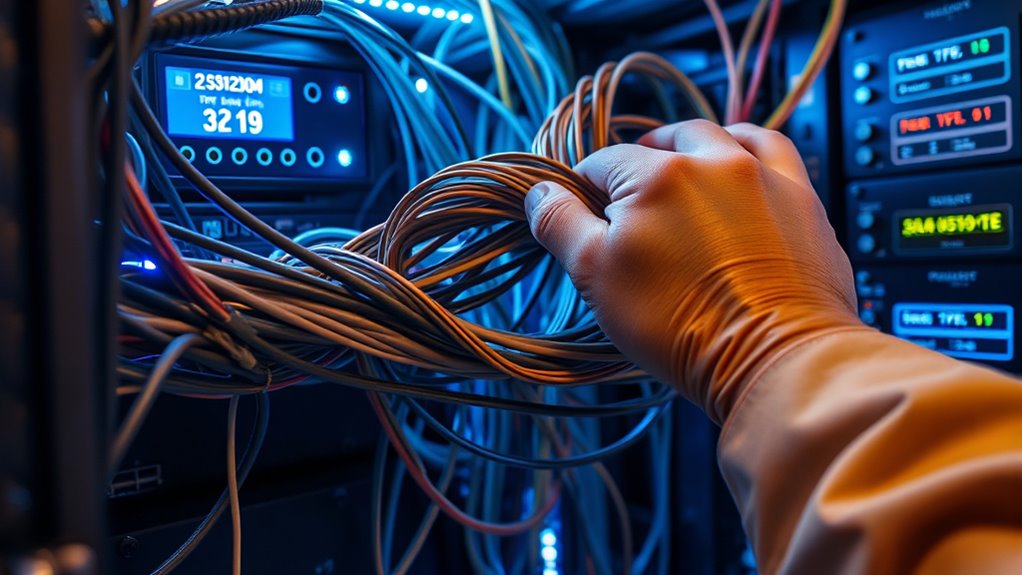
Before implementing any upgrade, you need to guarantee the system meets all necessary standards and performs reliably. Testing and certification are essential steps to verify signal integrity and confirm compliance with industry standards. You should conduct thorough testing, including continuity, cable length, and shielding effectiveness, to confirm the upgraded cabling maintains peak signal quality. Certification involves using certified testing equipment to validate that the installation meets local and international compliance standards. This process helps identify potential issues early, preventing future failures and ensuring reliable operation. Once testing is complete, document all results and obtain official certification. This documentation proves your system adheres to required standards and can be trusted for ongoing performance and safety. Proper testing and certification safeguard your investment and maintain system integrity.
Planning for Future Expansion and Maintenance
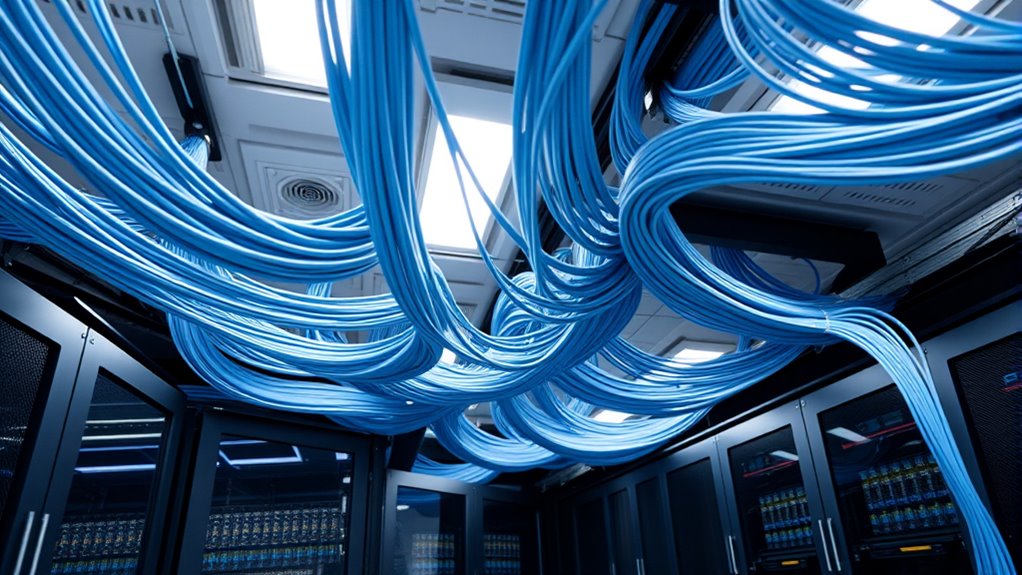
After completing testing and certification, it’s important to contemplate how your system will handle future growth and ongoing upkeep. Planning for expansion means designing your fiber optic infrastructure with scalability in mind, allowing for easy upgrades as demand increases. Consider integrating wireless solutions to reduce cabling complexity and enhance flexibility, especially in areas where wiring might be limited or difficult to access. Future-proofing also involves selecting durable components that require minimal maintenance and planning for regular inspections. Keep in mind that technology evolves rapidly, so leaving space for additional fiber runs or wireless access points ensures your system remains adaptable. By proactively planning, you reduce downtime and costly retrofits down the line, ensuring your cabling infrastructure stays current and efficient.
Frequently Asked Questions
How Long Does a Typical Retrofit Project Take?
A typical retrofit project takes anywhere from a few days to several weeks, depending on factors like cable compatibility and retrofit planning. If your existing cabling is straightforward to upgrade, it moves faster. However, complex setups or older infrastructure can extend the timeline. Proper planning helps minimize disruptions, ensuring the upgrade proceeds smoothly. You should consult with specialists to get a tailored estimate based on your specific infrastructure and needs.
What Safety Precautions Are Necessary During Installation?
Think of safety precautions as your shield against unseen dangers. During installation, you must carefully handle cables to prevent fire hazards caused by faulty wiring or insulation issues. Wear protective gear, ensure proper grounding, and keep fire extinguishers nearby. Regularly inspect insulation safety, avoiding damage that could lead to short circuits. By staying vigilant, you safeguard yourself and your environment from potential electrical fires and hazards lurking in old cabling.
Can Retrofit Options Be Customized for Specific Building Layouts?
Yes, retrofit options can be customized for specific building layouts. You have flexibility in customization, allowing you to adapt solutions to unique layout considerations. This flexibility ensures that upgrades fit seamlessly within your existing infrastructure, minimizing disruption. By working with professionals, you can tailor retrofit options to match your building’s design, guaranteeing peak performance and compliance with standards while respecting the distinctive features of your space.
What Is the Estimated Cost for Upgrading Old Cabling?
The cost estimate for upgrading old cabling varies based on your building size and existing infrastructure, but you should budget approximately $3 to $5 per linear foot for materials and labor. To plan effectively, you need to take into account your overall project scope, including any customization needs. Proper budget planning ensures you allocate enough funds for a seamless upgrade while avoiding unexpected expenses.
Are There Environmental Considerations When Replacing Old Cables?
Replacing old cables is like planting a tree; it’s vital to take into account the cable environmental impact. You should choose eco-friendly wiring options that minimize hazardous materials and reduce waste. Proper disposal prevents harmful substances from polluting soil and water. By selecting sustainable materials and following environmental regulations, you ensure your upgrade supports a healthier planet while maintaining reliable, modern connectivity.
Conclusion
Upgrading your cabling infrastructure is essential for future-proofing your network. Did you know that outdated cabling can cause up to 50% slower data speeds? By evaluating your current setup, choosing the right retrofit methods, and ensuring proper testing, you can boost performance and reliability. Remember, investing in quality upgrades now can save you time and money later, keeping your system running smoothly and ready for tomorrow’s demands.
